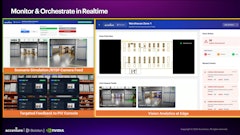
These are unprecedented times. Never before have we experienced such a global phenomenon, and yet at the same time, been so thoroughly connected across all nations and continents. For the first time in human history, no news or event feels “a world away.” Due to ever-progressing technological advances, people and organizations have access to immeasurable amounts of data from all across the globe, in real time. And, that's the problem.
For many, this influx of data can be overwhelming and paralyzing during the current crisis and can also exacerbate feelings of helplessness in the face of such a daunting task. How do we cope, as organizations and as people, with the worldwide economic and social devastation brought about by COVID-19?
In this case, the obstacle is the way.
During this pandemic, the same technological advances that allow us to experience fear and panic from all over the world also provide us with solutions for connectivity and resilience. There is no more debate—the Digital Revolution is officially here. While it may have been accelerated at both a personal and professional level by COVID-19, there is no putting the genie back in the bottle. We can either allow ourselves to become overwhelmed and paralyzed, or we can embrace the revolution and help the world get back to work.
Now more than ever, having visibility to accurately and efficiently integrated data is the difference between floundering and flourishing. Today’s supply chains span the entire globe, utilizing multiple modes, from ocean freight, to LTL, to parcel, and incorporate data from the point of online order entry all the way through to generating electronic invoices. As more industries pivot to online services in response to this crisis, paper trails and manual audits are falling hopelessly behind, and failing to cope with the demand. Likewise, businesses that have supply chain data separated into disparate silos also lack the ability to communicate accurately and efficiently enough to survive in the New Normal.
There is a solution though—integrated global data platforms. These systems offer companies the opportunity to access and harness the available supply chain data from around the world and utilize that data to make a difference.
Specifically, these platforms provide three key solutions during this current crisis:
Integrated carrier data
More than ever before, supply chains are going global. Companies are now shipping and receiving items from every corner of the world, and thus utilizing multiple carriers and modes of transportation. Prior to the digital revolution, this meant having data individually hoarded by each carrier and separated out by mode, providing little to no clarity across the entire supply chain. Due to the rise of integrated data platforms however, all of these disparate carrier systems can be brought into one location, giving businesses access and visibility to all of their data, across all carriers and modes, in one easy-to-use database.
Efficient mode and routing options
Access and visibility to multiple systems is only half the battle. Using those tools to find the right mode and most efficient route are the next step, and that takes sophisticated, real-time business intelligence technology. This is where integrated data platforms can make an immediate impact. While parcel carriers have been providing real-time tracking options in one form or another for some time now, the digital revolution is bringing this technology to ocean freight as well. Businesses can now track their cargo as it makes waves, literally, all over the world. Having access to packaging, weight and real-time tracking data across all modes in one centralized platform with the proper BI in place can lead to actionable decision making that not only increases efficiency, but helps protect a company’s bottom line.
Increased predictive capabilities
As people move online both personally and professionally, efficiency is the name of the game. The speed of business in today’s global supply chain is fast-paced to say the least, and only growing more so. Reacting to supply and demand is no longer enough. Knowing where products are at all times and where they will be needed in the future is the only way to stay ahead of the curve. Integrated global data platforms can allow companies to accurately predict spikes in demand at exact locations and efficiently move supplies beforehand to eliminate any delays or shortages. This keeps business flowing and customers happy.
Thanks to increased access to global data visibility, what we are seeing now, despite the economic shutdown, is that ships are crossing oceans with goods and supplies. Trucks are on the roads, and railways are still moving forward with speed. The ability to make business decisions based on numbers, instead of fear, is priceless. Supply chain continues to be a lifeblood of the nation’s economy, and though adjustments have been made throughout the industry, the data shows that our country’s heartbeat is still strong.
There will always be obstacles in the way, but the most important decision businesses can make right now is how they choose to meet those obstacles.
And make no mistake—in uncertain times like these, knowledge is our greatest power.







![Mark Burstein[2]](https://img.sdcexec.com/files/base/acbm/sdce/image/2020/06/mark_burstein_2_.5eda7a0c2d4f6.png?auto=format%2Ccompress&fit=crop&h=167&q=70&w=250)












